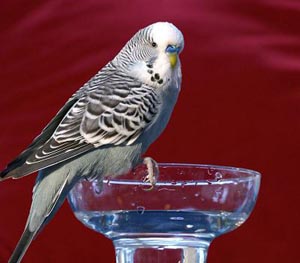Parakeet - Budgerigar
Budgie, Budgerigar, English Budgie, American Budgie Scientific Name: Melopstiiacus undulatus
Wed, 30th April, 2025 - 11:19 am GMT
Sponsor Ads:

Alternative Name
Budgie, Budgerigar, English Budgie, American Budgie Scientific Name: Melopstiiacus undulatusBasic Info
Many claim that males and females are easily distinguished by the color of their ceres (the area above their beaks). The cere of the female is brown, reddish, white or light beige, while the males usually have a blue cere. Many times, however, it is not possible to distinguish sexes based on cere color alone. Both sexes of some varieties, such as the Inos and the Fallow, have the same color cere. The small size of the budgie is another appealing feature to many parakeet owners. An adult budgie will be approximately seven inches in length (18 centimeters).
Health
It is important to feed your Budgerigar a well balanced diet. Many also recommend dietary supplements. Talk with your veterinarian about the correct diet and supplements. One of the leading causes of early death in pet budgies is improper nutrition. The other six main causes of illnesses in budgies are molds, parasites (including scaly face, feather lice, coccidiosis, ornithosis, and red mites), viral infections, poisoning, shock, and respiratory diseases. Budgies should be housed in cages that provide plenty of space for movement. 16 inches x 16 inches x18 inches is the minimum size that a single budgie should be housed in. Multiple birds will need a larger cage. Breeding Captive breeding of budgerigars is relatively easy to achieve and is commonly seen. Breeding seasons can begin at any time of year. The hen will usually lay four to five eggs, which incubate for a period of 18 days. The fledgling period lasts one month. The Please see the related article on budgie genetics for more information.Habitat
N/ABehavior
The Budgerigar is one of the most loved parrots around the world. And it's no surprise why. They are smart, affectionate, and beautiful. The Budgie can make a wonderful addition to any home. The Budgerigar, also known as the "Budgie" or "Parakeet", comes in a wide spectrum of color variations and many varieties, see the related story, "Budgies: A Rainbow of Colors!" on our website for more information. There are English and American varieties of budgies in addition the to budgies from their native country, Australia. The English Budgie is larger than its Australian and American counterparts and is most commonly seen in shows. They are a lot less active than their American cousins. The American versions are those most commonly seen in pet stores in the United States and Canada. The budgie is perhaps best loved for its friendly personality. These affectionate parrots give as much love as they like to receive. Some budgies are also excellent talkers. Their voices are not as distinct as those of the larger parrots, but one might be surprised how well these little parrots can talk. There is of course no guarantee your budgie will talk, but do not be surprised if he begins to mimic whistles and other household noises. Another engaging trait of the budgie is his ease of training. There are many methods of training and the budgie seems to respond quite well to all of them. Just remember to give your budgie time to adjust in his new home before you begin training. Budgerigars in the wild are social birds, traveling in a variety of flock sizes. Small flocks can number in the 1920s, while some have noted budgie flocks of over 25,000! Like domestic budgies, their wild counterparts are placid, even tempered, and outgoing. It is rare to see wild budgies quarrelling with each other. These wild budgies are not shy and are often easily approachable.Origin
AustraliaHistory
First discovered in 1805, the Budgerigar originates in Australia, but has quickly become a worldwide favorite. Because of the Budgerigar's immense popularity he is known by many names throughout the world. In his native Australia he is called "Bedgerigah", the French call them "Perruche Ondulee", the Dutch have named them "Grasparkiet", in Italy they are called Parrochetto. The Norwegiens and Swedish have named them Undulat, while the Germans call them "Wellensittich". Lastly, the Greeks call them "Papagalaki", and the Portuguese word for Budgerigar is "Periquito".Common Foods
Their natural diet consists of grass seeds, eucalyptus leaves, buds, bark, millet, and a variety of greens.Sponsor Ads:
The bigger they are, the harder they punch. -- Unknown
Parakeet - Budgerigar
Coded by: BGID® | ALL RIGHTS RESERVED Copyright © 2000-2025
Disclaimer | Privacy | Report Errors / Contact | Credits








 Preparing For China. China is growing their military. China Military Technology - can it keep up with the US?
Preparing For China. China is growing their military. China Military Technology - can it keep up with the US?  versus
versus 

 versus
versus 
 This Thread is about the North Korean Military itself - the kind of army, navy, and air force they have.
This Thread is about the North Korean Military itself - the kind of army, navy, and air force they have. 
 versus
versus 
 versus
versus  versus
versus